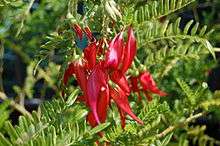Clianthus maximus
| Clianthus maximus | |
|---|---|
 | |
| Scientific classification | |
| Kingdom: | Plantae |
| (unranked): | Angiosperms |
| (unranked): | Eudicots |
| (unranked): | Rosids |
| Order: | Fabales |
| Family: | Fabaceae |
| Genus: | Clianthus |
| Species: | C. maximus |
| Binomial name | |
| Clianthus maximus Colenso | |
Clianthus maximus, commonly known as kaka beak (kōwhai ngutu-kākā in Māori), is a woody legume shrub native to New Zealand's North Island. It is one of two species of Clianthus (kaka beak) and both have striking clusters of red flowers which resemble the beak of the kākā, a New Zealand parrot.
The species is endangered in the wild, with only 153 trees found in a 2005 survey (down from over 1000 in 1996), in the East Coast and northern Hawkes Bay regions.[2]
William Colenso described C. maximus in 1885, identifying it as distinct from C. puniceus, the other kaka beak. However Thomas Kirk reduced C. maximus to a variety of C. puniceus (C. puniceus var. maximus) in 1899. Peter Heenan reinstated C. maximus as a separate species in 2000.[3]
Prior to the 1990s, C. maximus was rarely cultivated, most stock available for cultivation being C. puniceus (then C. puniceus var. puniceus). C. maximus is now widely available in garden shops in New Zealand, however,.[4]
References
- ↑ de Lange (1998). Clianthus puniceus. 2007 IUCN Red List of Threatened Species. IUCN 2007. Retrieved on 30 July 2008. Listed as Endangered (EN D v2.3). This pre-2000 entry refers to C. puniceus sensu lato.
- ↑ Wild kaka beak close to extinction, New Zealand Biodiversity, 23 December 2005. Retrieved 28 July 2008.
- ↑ Heenan, P.B. (2000). "Clianthus (Fabaceae) in New Zealand: a reappraisal of Colenso's taxonomy" (PDF). New Zealand Journal of Botany. 38: 361–371. doi:10.1080/0028825x.2000.9512688. ISSN 0028-825X. Retrieved 2010-11-14.
- ↑ "Clianthus maximus". New Zealand Plant Conservation Network. Retrieved 2008-07-28.
External links
| Wikimedia Commons has media related to Clianthus maximus. |
- Clianthus maximus Colenso (1885), Ngā Tipu o Aotearoa - New Zealand Plant Names Database. Landcare Research, New Zealand.
